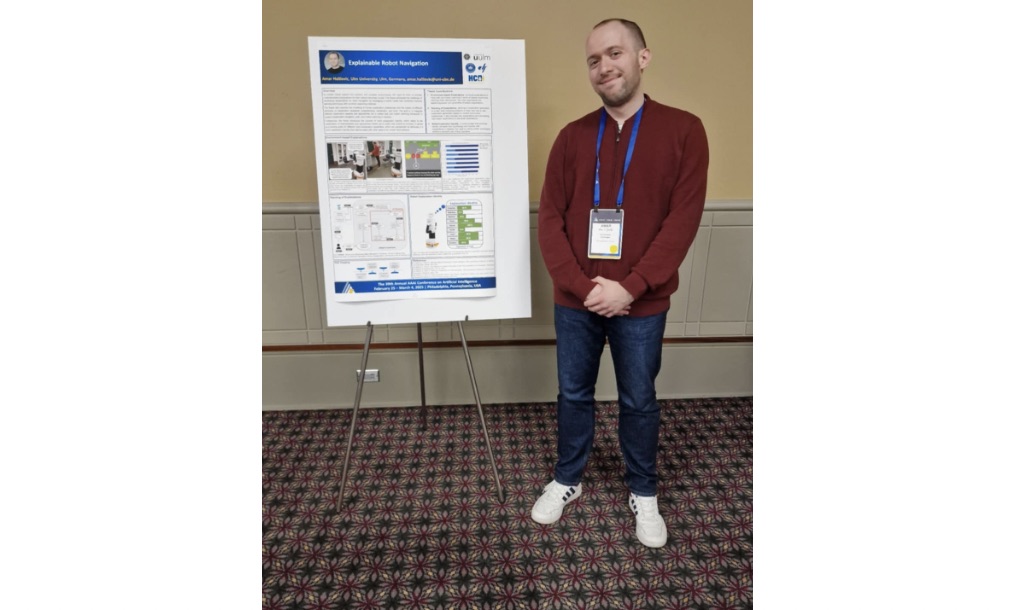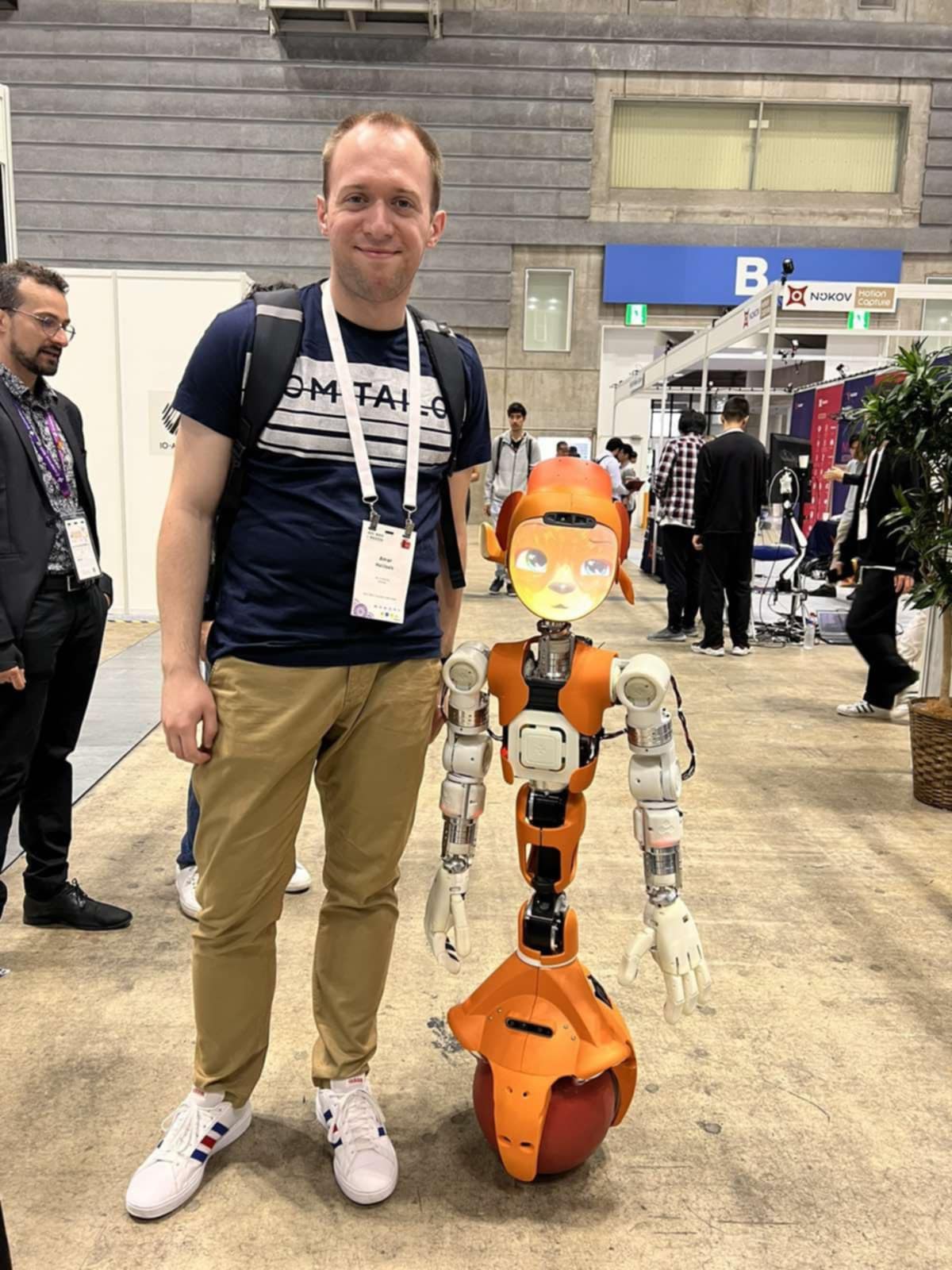Debut of LLM-enabled humanoid robot at event met with mixed reviews by human attendees
Interview with Amar Halilovic: Explainable AI for robotics

In this interview series, we’re meeting some of the AAAI/SIGAI Doctoral Consortium participants to find out more about their research. The Doctoral Consortium provides an opportunity for a group of PhD students to discuss and explore their research interests and career objectives in an interdisciplinary workshop together with a panel of established researchers. In this latest interview, we hear from Amar Halilovic, a PhD student at Ulm University.
Tell us a bit about your PhD – where are you studying, and what is the topic of your research?
I’m currently a PhD student at Ulm University in Germany, where I focus on explainable AI for robotics. My research investigates how robots can generate explanations of their actions in a way that aligns with human preferences and expectations, particularly in navigation tasks.
Could you give us an overview of the research you’ve carried out so far during your PhD?
So far, I’ve developed a framework for environmental explanations of robot actions and decisions, especially when things go wrong. I have explored black-box and generative approaches for the generation of textual and visual explanations. Furthermore, I have been working on planning of different explanation attributes, such as timing, representation, duration, etc. Lately, I’ve been working on methods for dynamically selecting the best explanation strategy depending on the context and user preferences.
Is there an aspect of your research that has been particularly interesting?
Yes, I find it fascinating how people interpret robot behavior differently depending on the urgency or failure context. It’s been especially rewarding to study how explanation expectations shift in different situations and how we can tailor explanation timing and content accordingly.
What are your plans for building on your research so far during the PhD – what aspects will you be investigating next?
Next, I’ll be extending the framework to incorporate real-time adaptation, enabling robots to learn from user feedback and adjust their explanations on the fly. I’m also planning more user studies to validate the effectiveness of these explanations in real-world human-robot interaction settings.
 Amar with his poster at the AAAI/SIGAI Doctoral Consortium at AAAI 2025.
Amar with his poster at the AAAI/SIGAI Doctoral Consortium at AAAI 2025.
What made you want to study AI, and, in particular, explainable robot navigation?
I’ve always been interested in the intersection of humans and machines. During my studies, I realized that making AI systems understandable isn’t just a technical challenge—it’s key to trust and usability. Robot navigation struck me as a particularly compelling area because decisions are spatial and visual, making explanations both challenging and impactful.
What advice would you give to someone thinking of doing a PhD in the field?
Pick a topic that genuinely excites you—you’ll be living with it for several years! Also, build a support network of mentors and peers. It’s easy to get lost in the technical work, but collaboration and feedback are vital.
Could you tell us an interesting (non-AI related) fact about you?
I have lived and studied in four different countries.
About Amar

|
Amar is a PhD student at the Institute of Artificial Intelligence of Ulm University in Germany. His research focuses on Explainable Artificial Intelligence (XAI) in Human-Robot Interaction (HRI), particularly how robots can generate context-sensitive explanations for navigation decisions. He combines symbolic planning and machine learning to build explainable robot systems that adapt to human preferences and different contexts. Before starting his PhD, he studied Electrical Engineering at the University of Sarajevo in Sarajevo, Bosnia and Herzegovina, and Computer Science at Mälardalen University in Västerås, Sweden. Outside academia, Amar enjoys travelling, photography, and exploring connections between technology and society. |
NVIDIA RTX PRO BLACKWELL DESKTOP GPUs
VIDIA RTX PRO™ BLACKWELL DESKTOP GPUs
NVIDIA RTX PRO™ BLACKWELL DESKTOP GPUs
NVIDIA RTX PROâ„¢ BLACKWELL DESKTOP GPUs
Smart adaptation: The fusion of AI and robotics for dynamic environments
Single-sensor 3D microphone enables robots to locate humans in noisy environments
Light and AI drive precise motion in soft robotic arm
Robotic hand with unprecedented tactile sensitivity achieves human-like dexterity in real-world tasks
From Displacement to Empowerment: How Robotics Developers Can Lead the Workforce Reskilling Revolution
ChatGPT: The Number One Choice in U.S.
A new study from ComScore finds that ChatGPT is the number one choice for AI among Americans using desktop PCs – by a long-shot.
Specifically, ComScore found that ChatGPT currently enjoys 35.7 million visits each month from the U.S. – or more visits than any other competitor.
Moreover, the second-most-popular AI, Microsoft Copilot – with 30.3 million monthly visits – primarily runs on ChatGPT technology lightly customized by Microsoft.
Coming in third place was Canva, an AI content creation tool, with 17.8 million monthly visits.
And rounding out the field was Grammarly, an AI writer and editor, with 8.7 million monthly visits and Voicemod, an AI audio tool, with 4.3 million visits.
ChatGPT was also number one among Americans using the AI on mobile, with 21.5 million visits-per-month, according to ComScore.
Equally noteworthy: The number one users of AI in the U.S. – and across the globe – are students.
(Worldwide, ChatGPT is currently averaging 4.5 billion visits each month, according to DemandSage.)
In other news and analysis on AI writing:
*Making Your Headshot Talk: Character.ai Says Its Solution ‘On the Way:’
AI pioneer Character.ai is promising to roll-out new AI tech that enables your headshot – and other still images – to talk from a script.
While the lip-syncing of Character.ai’s creations is not perfect, it’s still an interesting application of AI that writers may want to use to give an edgier feel to their Web sites and other digital properties.
You can check-out examples of Character.ai’s images-to-talking heads here.
*ChatGPT’s Long-Term Plan: ChatGPT as Omni-Assistant: ChatGPT’s maker has revealed that the ultimate manifestation of ChatGPT will be an AI omni-assistant that knows everything about you — and hopefully be able to fulfill your every need.
According to an internal strategy document, “OpenAI plans to evolve ChatGPT into a super-assistant that knows you, understands what you care about and helps with any task that a smart, trustworthy, emotionally intelligent person with a computer could do,” according to writer Akash Dutta.
For some, that prospect may seem a bit creepy.
But for others – who are disciplined about what they input into ChatGPT – the rewards could be substantial.
*Gmail Accounts with Gemini Now Offer Email Auto-Summaries: Gmail users who use their account with ChatGPT-competitor Gemini will now see all of their longer emails automatically summarized.
Observes writer Sarah Perez: “Users no longer have to tap an option to summarize an email with AI.
“Instead, the AI will now automatically summarize the content when needed — without requiring user interaction.”
*Gemini Now Offers Instant Updates on Your Collaborations in Google Drive: Collaborators looking for what’s changed on a shared project can now use Gemini to unearth those insights from Google Drive.
Observes writer Artie Beaty: “Google recently announced a new feature called ‘Catch Me Up.’
”Gemini can tell when changes are made to files in your Google Drive since you last viewed it and give you an overview of what’s new.”
*ChatGPT Competitor Offers Primer on Its Deep Research Mode: Claude – a direct competitor to ChatGPT – now has an in-depth primer you can use to get the most from its deep research mode.
Observes the Claude-maker Anthropic: “Research transforms how Claude finds and analyzes information.
”Claude operates agentically, conducting multiple searches that build on each other while determining exactly what to investigate next.
”It explores different angles of your question automatically and works through open questions systematically.
“With Research, Claude delivers thorough answers in minutes, complete with easy-to-check citations so you can trust Claude’s findings.”
*New AI Offers a Team of Virtual Employees: New cloud software from OnlineAssistant.ai offers small businesses a number of virtual employees they can leverage for growth.
The productivity suite includes:
*An AI research and strategy assistant, which can automatically engage in business planning, generate market insights and draft research-backed reports — in seconds
*A virtual business assistant, which can automate customer support, appointment scheduling, proposal writing and internal task management
*Integration with other automation-friendly tools, including Zapier, Notion, Google Docs and more
*Washington Post: Got an Opinion? Let Our AI Write It for You: Sages on bar stools across the globe, rejoice: The Washington Post is working on new AI that will forge your words of wisdom into op-ed gems.
Dubbed ‘Ember,’ the tool promises to automate several functions provided by human editors, including helping amateur writers develop an early thesis, supporting points and a memorable ending to their unique perspectives.
Observes writer Emma Roth: “The move is reportedly part of a broader initiative to open the paper to outside opinion pieces.”
*Getting Clear on AI Agents: A Microsoft Primer: Writers looking for a quick study on how AI agents will be changing their workday can now get one free from Microsoft.
The tech titan has put together a one-hour video on YouTube that hits the highlights on AI agents, subdivided into ten, easily digested lessons.
AI agents are seen as the second wave of generative AI, and are designed to work independently on a number of tasks to complete a specific mission – such as researching, gathering quotes and writing an article or report.
*AI BIG PICTURE: Push for Regulation-Free AI in U.S. Encounters Flak: Trump’s desire to keep AI from from regulation in the U.S. for the next 10 years is encountering resistance on the state level.
Specifically, a bipartisan coalition of 260+ state legislators from all 50 U.S. states have written an open letter to Trump opposing the move.
Part of Trump’s “Big, Beautiful Bill” now making its way through the U.S. Congress, the fate of AI regulation is extremely high-stakes for the tech.
Opponents fear that without regulation, AI will become a runaway train beyond human control.
But proponents counter that if AI is shackled with regulations in the U.S., competitors like China could lunge ahead in coming years – and ultimately own the keys to the AI kingdom.

Share a Link: Please consider sharing a link to https://RobotWritersAI.com from your blog, social media post, publication or emails. More links leading to RobotWritersAI.com helps everyone interested in AI-generated writing.
–Joe Dysart is editor of RobotWritersAI.com and a tech journalist with 20+ years experience. His work has appeared in 150+ publications, including The New York Times and the Financial Times of London.
The post ChatGPT: The Number One Choice in U.S. appeared first on Robot Writers AI.

